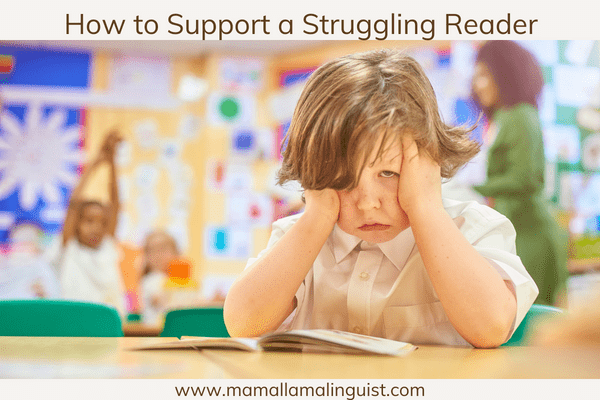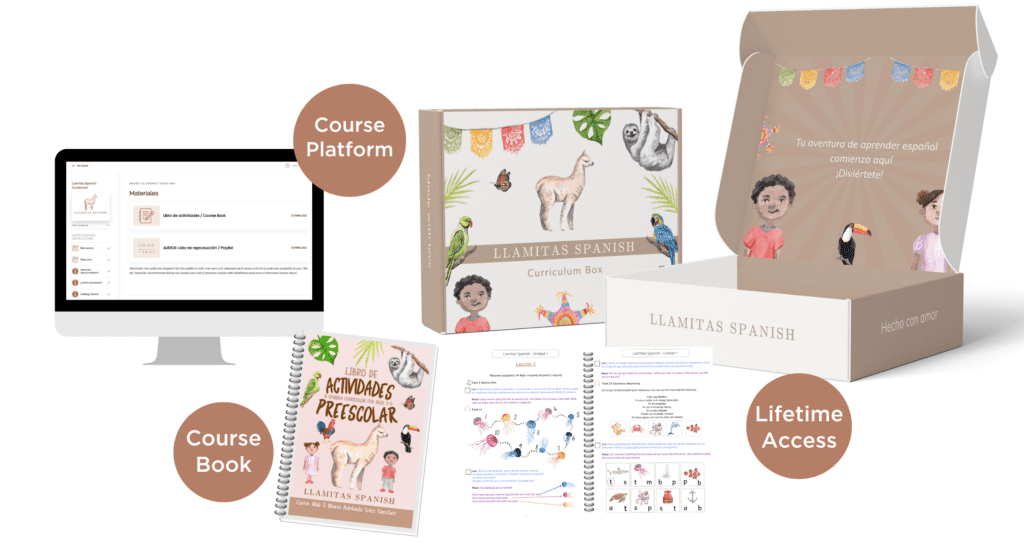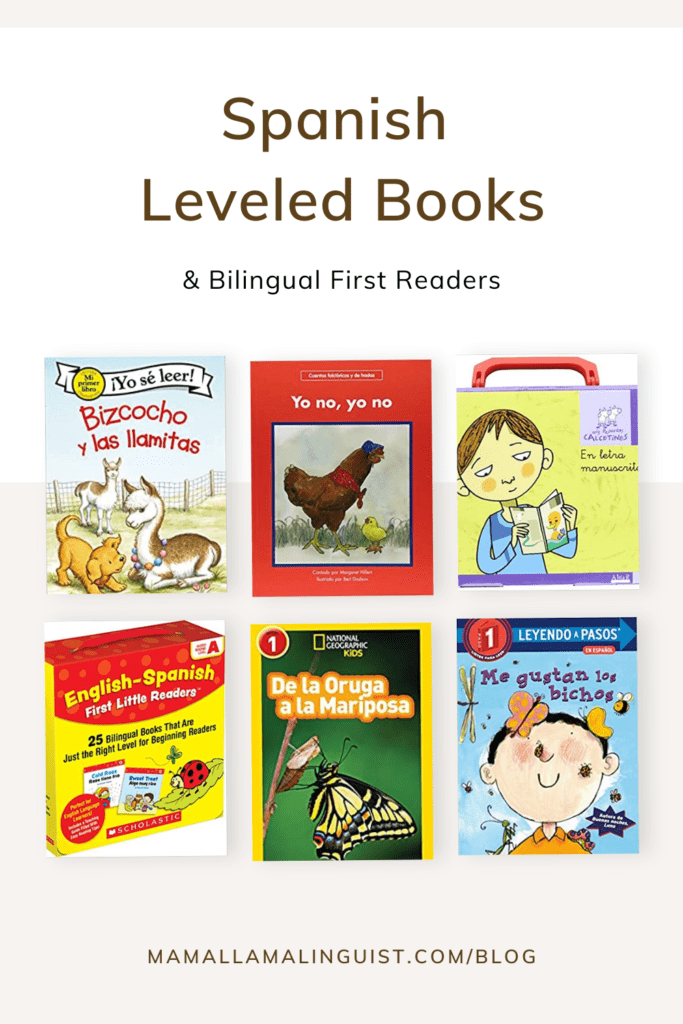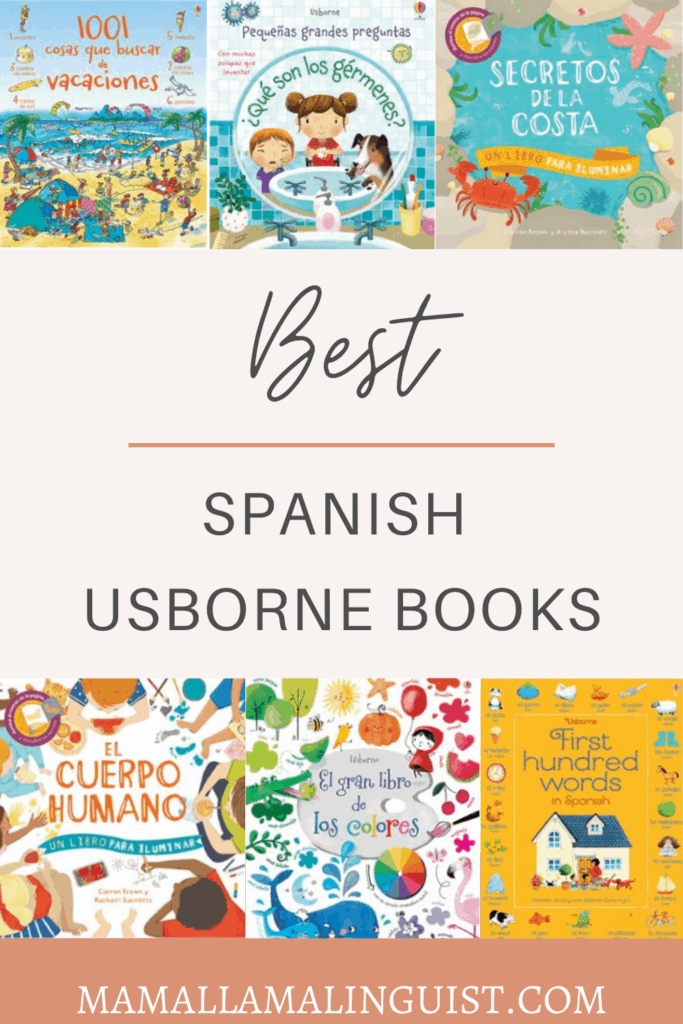In this post: Common reasons why you have a struggling reader and tips for supporting your bilingual child to read in English and Spanish.
Literacy is such an important life skill, so it’s normal for parents to worry if their child struggles with reading. While early intervention for reading difficulties is recommended, problems with reading are probably more common than you think.
Since the start of the pandemic, children’s reading levels have declined nationwide, according to a recent assessment by the National Center for Education Statistics (NCES). Remote learning and the added stress on families are likely to blame for this drop in reading skills.
Bilingual families have the additional challenge of navigating teaching your child to read in two languages. This can lead to unbalanced language skills, especially if your child only uses one language at school, leaving you to support the minority language at home.

This post contains affiliate links. As an Amazon Associate I earn from qualifying purchases.
For practicing Spanish at home, we recommend our Llamitas Spanish Curriculum: an open and go thematic curriculum that develops phonics and reading skills.
For the English language, we recommend the All About Reading program for a complete, no gaps system to reading fluency.
Just like with other milestones, when it comes to reading, every child is different and develops at their own pace. If you have more than one child, it’s easy to expect younger children to reach developmental stages at the same age as their siblings, but this often isn’t the case.
Each and every child is unique, and it’s important to remember that. With that in mind, there are some things you can do to help a child struggling with reading.
What are Some Causes of Reading Difficulties?
There are many factors that can lead to reading difficulties in children. The causes can range from environmental factors to reading disorders and even physical problems.
Some common causes of reading difficulties include:
- Dyslexia. This reading disorder makes it difficult to recognize and decode printed words. It may be caused by environmental or genetic factors, and is seen in individuals with normal intelligence and vision. Tutoring and early intervention can be helpful for children with dyslexia.
- Reading comprehension disorder. Some children struggle to understand the meaning of what they read. This can lead to frustration and difficulty with word recognition. Children with dyslexia, ADHD, and autism are at higher risk for reading comprehension disorder.
- Lack of phonological awareness. Understanding spoken language is an important step toward learning how to read. Children need to develop phonological awareness, or an understanding of how language sounds, before they can learn to read fluently.
- Lack of access to books or little exposure to reading. Even before your child is actively learning to read, it’s important for them to be exposed to stories and other printed materials. This can help to strengthen overall language skills and the building blocks needed for reading comprehension.
- Reluctant reader. Some kids just aren’t interested in books, which can affect reading skills. You may need to get creative to get your child interested in reading, and we’ll share some strategies for that below.
While it’s never too late to help your child improve their reading skills, supporting literacy skills as early as possible is best.
If you’re raising your preschooler bilingual, we recommend our Preschool Spanish Morning Binder. This mini course includes printables that will introduce your little one to the Spanish alphabet, shapes, colors, and more!
Related post: Bilingual Parenting Podcasts
When to Seek Professional Help for Reading Struggles
If you’re wondering if your child might need professional intervention for their reading struggles, the best thing you can do is actually talk to a professional.
For reading difficulties in elementary students, reach out to your child’s school or teacher. They can tell you if they’ve noticed anything in class and if your child’s reading level is lower than expected for their grade level. Your child’s school may have a reading specialist, speech-language pathologist, or tutoring available.
Outside of school, your child’s doctor can rule out any physical issues that might be causing their reading difficulties, like vision or hearing problems. They may refer you to a specialist that can assess your child and determine the cause of their reading struggles.
Related post: How to Raise a Biliterate Child
6 Strategies to Help Your Struggling Reader at Home
Whether you want to help your bilingual child learn how to read fluently in two languages or you’re looking for ways to address some serious reading difficulties, there are certainly some ways to help your struggling reader at home.
Try some of the following strategies to help your struggling reader at home:
- Read aloud for 20 minutes every day.
According to the American Academy of Pediatrics, even reading to your child in infancy can help to give their reading skills a boost. While it may seem a little silly reading to your newborn, you can feel good knowing that you’re giving them a head-start in their language development.
In a bilingual or multilingual household, this might mean picking out baby books in Spanish and English to read every day. Be sure to balance exposure to both languages to promote strong reading skills in each one.
- Create a print rich environment at home.
Having age appropriate books around the house is a great way to promote reading at an early age. Your local library is a great resource for free books, and likely offers books in Spanish as well.
Around the house, you can even use items like a forward-facing book display or alphabet posters so your child can see printed letters and words easily.
- Use leveled books and readers.
Leveled books and readers are designed specifically for children who are learning how to read. You can find leveled readers for beginners that have simplified language and gradually move up to more advanced levels as your child’s reading skills improve.
Choosing books that are appropriate for your child’s reading level will help to reduce frustration. You might even want to start with books that are below their current level to boost confidence before moving on to more challenging material.
For English titles with your child’s favorite characters—like Disney princesses and Buzz Lightyear—the Step Into Reading books are a popular choice. For your bilingual child, there are plenty of great Spanish leveled books, too!
- Find books that tap into your child’s interests.
This is especially important if you have a reluctant reader. Many kids aren’t interested in reading, but finding books that they enjoy can make a huge difference. Spend some time with them exploring your local library—and let them lead the way.
Keep in mind that your child may not be interested in standard picture books, and that’s okay because there are so many types of books out there. Nonfiction, graphic novels, and even search and find books might keep their interest and help to improve reading comprehension.
Related post: Spanish Chapter Books for Kids
- Make reading fun with interactive books.
While you may think of reading as a quiet, solitary activity, research shows that making it more of an interactive experience boosts early childhood literacy. This might mean asking your child questions as you read, using silly voices, or choosing interactive books.
For younger children, touch and feel books and lift-the-flap books are engaging options. Any books from the Shine-a-Light series are a fun choice, too. With these books, your child can shine a flashlight behind pages to reveal hidden images. And the great news for bilingual families is that these are all available in English and Spanish!
Related post: Interactive Bilingual Books for Kids
- Use apps for more reading practice.
Let’s face it—kids love their screen time. While we know it’s best to limit time spent on apps and electronics, why not make the most of that time with apps that promote literacy? There are actually some great educational apps out there for kids that can help give your child the extra reading practice they need.
ABC Mouse is an award-winning app that comes highly recommended by parents and teachers. It has play-based, interactive games and activities that support literacy skills, from letter recognition and sounds to reading full stories.
Things you’ll love about ABC Mouse:
- Content in both English and Spanish
- Over 450 books to read
- Introduces your child to letters names and sounds, phonics, rhyming, sentence structure, and parts of speech
- Allows your child to gradually advance from reading a few words to reading full paragraphs
FabuLingua is the best app out there for learning how to read in Spanish. It teaches children how to read in Spanish through interactive stories and games, and will also give them some practice reading aloud.
Things you’ll love about FabuLingua:
- Beautifully illustrated stories
- Vocabulary games
- Choose to hear stories in Spanish only or include English translations of each sentence
- CopyCat feature gives your child practice reading sentences aloud
- Fun reward stickers as your child advances through the storypath
Related post: FabuLingua Spanish Kids App Review
Related Posts:



